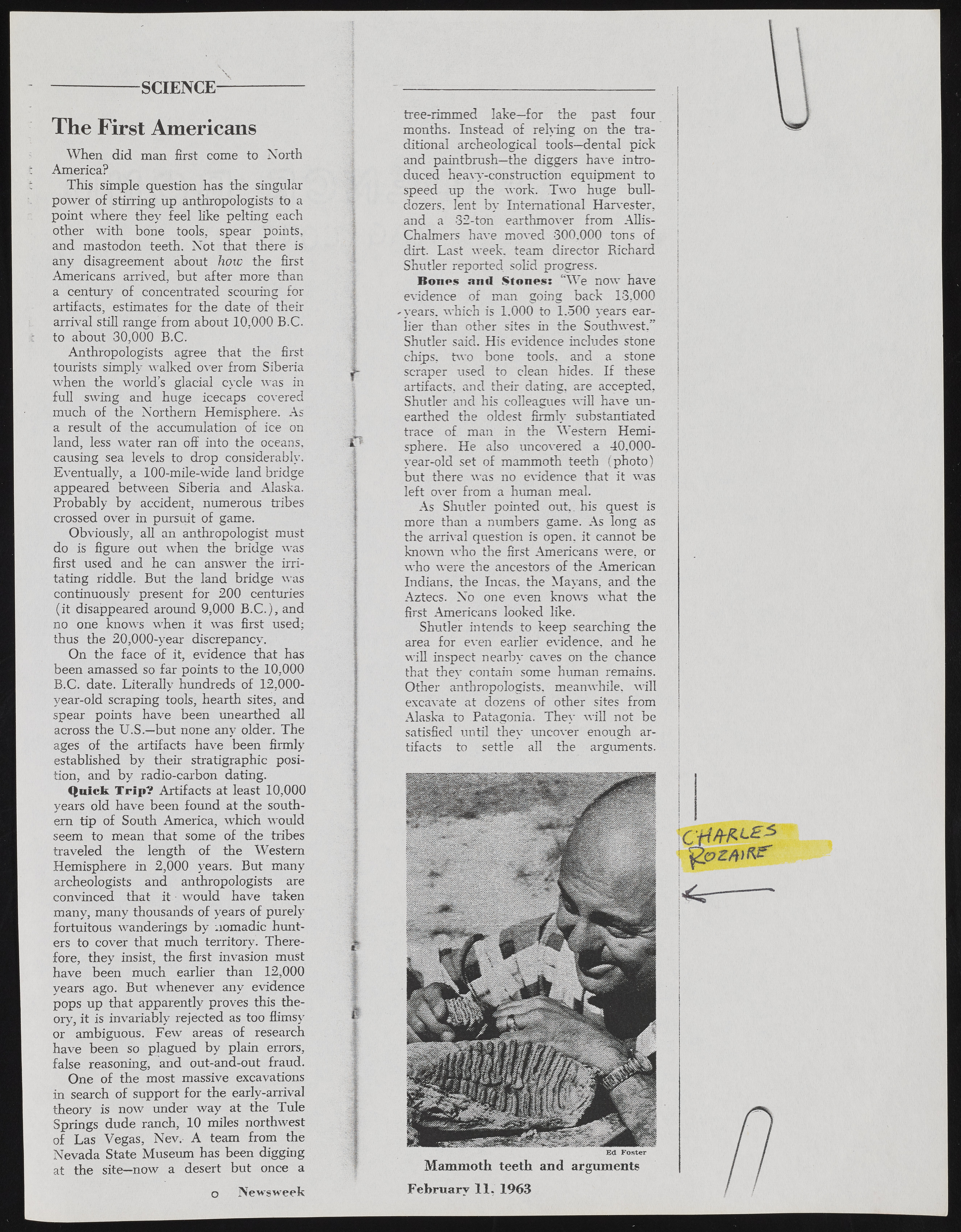Copyright & Fair-use Agreement
UNLV Special Collections provides copies of materials to facilitate private study, scholarship, or research. Material not in the public domain may be used according to fair use of copyrighted materials as defined by copyright law. Please cite us.
Please note that UNLV may not own the copyright to these materials and cannot provide permission to publish or distribute materials when UNLV is not the copyright holder. The user is solely responsible for determining the copyright status of materials and obtaining permission to use material from the copyright holder and for determining whether any permissions relating to any other rights are necessary for the intended use, and for obtaining all required permissions beyond that allowed by fair use.
Read more about our reproduction and use policy.
I agree.Information
Digital ID
Permalink
Details
More Info
Rights
Digital Provenance
Publisher
Transcription
S C IE N C E The First Americans j When did man first come to North America? This simple question has the singular power of stirring up anthropologists to a point where they feel like pelting each other with bone tools, spear points, and mastodon teeth. Not that there is any disagreement about how the first Americans arrived, but after more than a century of concentrated scouring for artifacts, estimates for the date of their arrival still range from about 10,000 B.C. to about 30,000 B.C. Anthropologists agree that the first tourists simply walked over from Siberia when the worlds glacial cycle was in full swing and huge icecaps covered much of the Northern Hemisphere. As a result of the accumulation of ice on land, less water ran off into the oceans, causing sea levels to drop considerably. Eventually, a 100-mile-wide land bridge appeared between Siberia and Alaska. Probably by accident, numerous tribes crossed over in pursuit of game. Obviously, all an anthropologist must do is figure out when the bridge was first used and he can answer the irritating riddle. But the land bridge was continuously7 present for 200 centuries (it disappeared around 9,000 B.C.), and no one knows when it was first used; thus the 20,000-year discrepancy. On the face of it, evidence that has been amassed so far points to the 10,000 B.C. date. Literally hundreds of 12,000- vear-old scraping tools, hearth sites, and spear points have been unearthed all across the U.S.—but none anv older. The ¥ ages of the artifacts have been firmly established by their stratigraphic position, and by radio-carbon dating. Q uick Trip? Artifacts at least 10,000 years old have been found at the southern tip of South America, which would seem to mean that some of the tribes traveled the length of the Western Hemisphere in 2,000 years. But many archeologists and anthropologists are convinced that it would have taken many, many thousands of years of purely fortuitous wanderings by nomadic hunters to cover that much territory. Therefore, they insist, the first invasion must have been much earlier than 12,000 years ago. But whenever any evidence pops up that apparently proves this theory, it is invariably7 rejected as too flimsy or ambiguous. Few areas of research have been so plagued by plain errors, false reasoning, and out-and-out fraud. One of the most massive excavations in search of support for the early-arrival theory is now under way at the Tule Springs dude ranch, 10 miles northwest of Las Vegas, Nev. A team from the Nevada State Museum has been digging at the site—now a desert but once a tree-rimmed lake—for the past four months. Instead of relying on the traditional archeological tools—dental pick and paintbrush—the diggers have introduced heavy-construction equipment to speed up the work. Two huge bulldozers, lent by International Harvester, and a 32-ton earthmover from Allis- Chaimers have moved 300.000 tons of dirt. Last week, team director Richard Shutler reported solid progress. B ones am i Stones: “We now have evidence of man going back 13,000 -years, which is 1.000 to 1.500 years earlier than other sites in the Southwest,” Shutler said. His evidence includes stone chips, two bone tools, and a stone scraper used to clean hides. If these artifacts, and their dating, are accepted, Shutler and his colleagues will have unearthed the oldest firmly substantiated trace of man in the Western Hemisphere. He also uncovered a 40,000- vear-old set of mammoth teeth (photo) but there was no evidence that it was left over from a human meal. As Shutler pointed out,, his quest is more than a numbers game. As long as the arrival question is open, it cannot be known who the first Americans were, or who were the ancestors of the American Indians, the Incas, the Mayans, and the Aztecs. No one even knows what the first Americans looked like. Shutler intends to keep searching the area for even earlier evidence, and he will inspect nearby caves on the chance that they contain some human remains. Other anthropologists, meanwhile, will excavate at dozens of other sites from Alaska to Patagonia. They will not be satisfied until they uncover enough artifacts to settle all the arguments. Ed F o ster Mammoth teeth and arguments o Newsweek February 11, 1963

